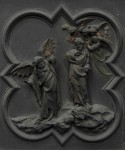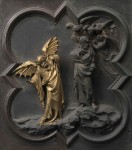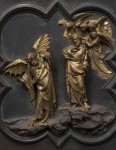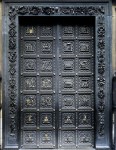 Lorenzo Ghiberti, the sculptor and goldsmith who created the gilded bronze doors to Florence’s Baptistery of San Giovanni that Michelangelo considered “so beautiful that they would do well for the gates of Paradise”, started out with a more modest assignment. The Arte di Calimala, the cloth importers guild of Florence, held a contest in 1401 to design a new set of doors for the Baptistery that would complement the bronze ones made by Andrea Pisano in 1330. Pisano’s doors graced the east side of the Baptistery in place of pride facing the Duomo, and consisted of 28 barbed quatrefoil panels depicting the life of St. John the Baptist and the eight virtues. Each contestant was given a year to submit a test panel on the subject of The Sacrifice of Isaac.
Lorenzo Ghiberti, the sculptor and goldsmith who created the gilded bronze doors to Florence’s Baptistery of San Giovanni that Michelangelo considered “so beautiful that they would do well for the gates of Paradise”, started out with a more modest assignment. The Arte di Calimala, the cloth importers guild of Florence, held a contest in 1401 to design a new set of doors for the Baptistery that would complement the bronze ones made by Andrea Pisano in 1330. Pisano’s doors graced the east side of the Baptistery in place of pride facing the Duomo, and consisted of 28 barbed quatrefoil panels depicting the life of St. John the Baptist and the eight virtues. Each contestant was given a year to submit a test panel on the subject of The Sacrifice of Isaac.
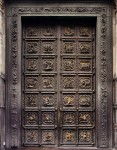 Vasari describes each submission in his Lives of the Artists and it’s clear that in his opinion Ghiberti’s was superior to everyone’s, including Donatello’s and Jacopo della Quercia’s. The two finalists were the young Ghiberti and Filippo Brunelleschi, future builder of the Duomo’s dome. Ghiberti claims in his autobiography that he was the unanimous winner; Vasari agrees. Brunelleschi’s biographer Antonio Manetti says Giberti and Brunelleschi were both given the assignment but Brunelleschi had no interest in collaborating so he went off to study architecture in Rome and left Ghiberti to do all the work himself.
Vasari describes each submission in his Lives of the Artists and it’s clear that in his opinion Ghiberti’s was superior to everyone’s, including Donatello’s and Jacopo della Quercia’s. The two finalists were the young Ghiberti and Filippo Brunelleschi, future builder of the Duomo’s dome. Ghiberti claims in his autobiography that he was the unanimous winner; Vasari agrees. Brunelleschi’s biographer Antonio Manetti says Giberti and Brunelleschi were both given the assignment but Brunelleschi had no interest in collaborating so he went off to study architecture in Rome and left Ghiberti to do all the work himself.
Ghiberti spent 21 years from 1403 to 1424 crafting his 28 barbed quatrefoil panels depicting the life of Christ, the four evangelists and the Church Fathers. The high relief gilded bronze scenes demonstrated his impressive command of design and casting. The dimension and dynamism of the composition eclipsed the more static, flat designs of Pisano’s making the doors huge hits and the artist famous. Pisano’s doors were moved to the west portal (later moved again to the south portal) and Ghiberti’s new ones took pole position on the east side.
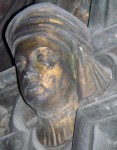 So thrilled was the Calimala organization with the doors, as soon as they were installed the guild commissioned Ghiberti to make a new set. This time they put no conditions on him whatsoever, no need to match the look of the Pisano doors and therefore no need to squeeze 28 small scenes into barbed quatrefoil borders. For this project Ghiberti chose to expand his canvas, dividing the door into 10 large squares that could accommodate his novel vision of several scenes from Old Testament episodes sharing space on the same panel. He used deep perspective and different depths of relief to capture figures in motion, taking full advantage of the architectural space. It took him 27 years to make these doors, his masterpiece, which would become known as the Gates of Paradise.
So thrilled was the Calimala organization with the doors, as soon as they were installed the guild commissioned Ghiberti to make a new set. This time they put no conditions on him whatsoever, no need to match the look of the Pisano doors and therefore no need to squeeze 28 small scenes into barbed quatrefoil borders. For this project Ghiberti chose to expand his canvas, dividing the door into 10 large squares that could accommodate his novel vision of several scenes from Old Testament episodes sharing space on the same panel. He used deep perspective and different depths of relief to capture figures in motion, taking full advantage of the architectural space. It took him 27 years to make these doors, his masterpiece, which would become known as the Gates of Paradise.
When complete, they were installed in the east portal. Ghiberti’s first doors were moved to the north portal where they still stand today. Centuries of pollution, vandalism, aggressive polishing and exposure to the elements coated the panels with thick blank gunk and damaged the gilding that remained underneath it. In 1980, experts with the Opificio delle Pietre Dure di Firenze, a public art restoration institute, initiated a long-term plan of study and conservation of the Gates of Paradise. The learning curve was steep; new laser technology even had to be developed to clean the gilding without overheating it. After 27 years of intensive work, the gleaming gold Gates of Paradise were returned to their former splendor and put on display in the Museo dell’Opera di Santa Maria del Fiore. (A replica is in place in the Baptistery.)
 Now it’s the north doors’ turn. All the hard-learned lessons from the restoration of the Gates of Paradise has drastically decreased the time projected to clean the north doors. In just a few months, already two of the panels, The Baptism of Christ and The Temptation of Christ have gone from black to shiny gold. The remaining 26 panels, the decorative borders, the 47 heads of prophets, sibyls and Ghiberti himself wearing a dashing turban are scheduled to be completed in autumn of 2015, after which they will go on permanent display in a compressed air case next to the Gates of Paradise in the new Museo dell’Opera.
Now it’s the north doors’ turn. All the hard-learned lessons from the restoration of the Gates of Paradise has drastically decreased the time projected to clean the north doors. In just a few months, already two of the panels, The Baptism of Christ and The Temptation of Christ have gone from black to shiny gold. The remaining 26 panels, the decorative borders, the 47 heads of prophets, sibyls and Ghiberti himself wearing a dashing turban are scheduled to be completed in autumn of 2015, after which they will go on permanent display in a compressed air case next to the Gates of Paradise in the new Museo dell’Opera.
